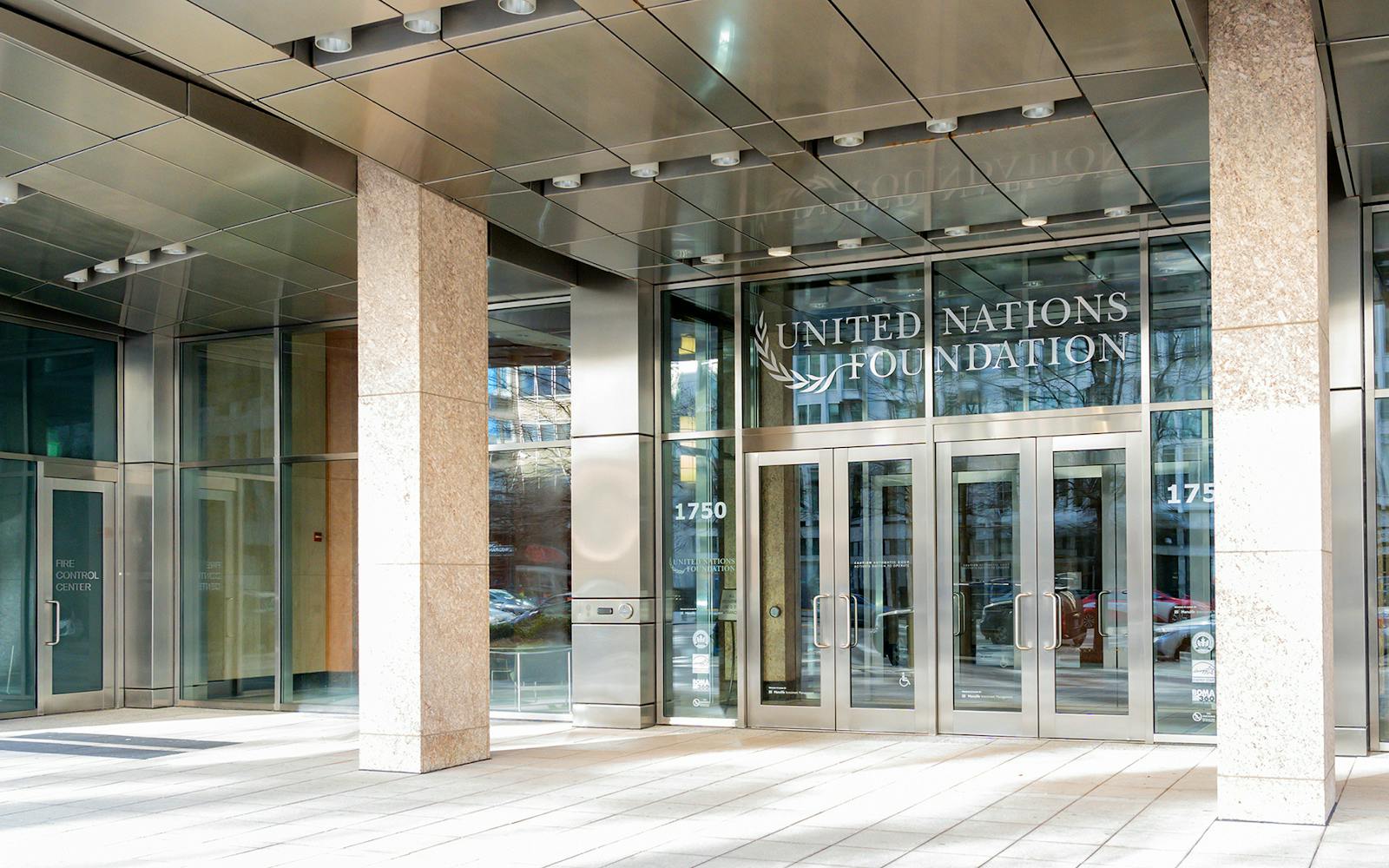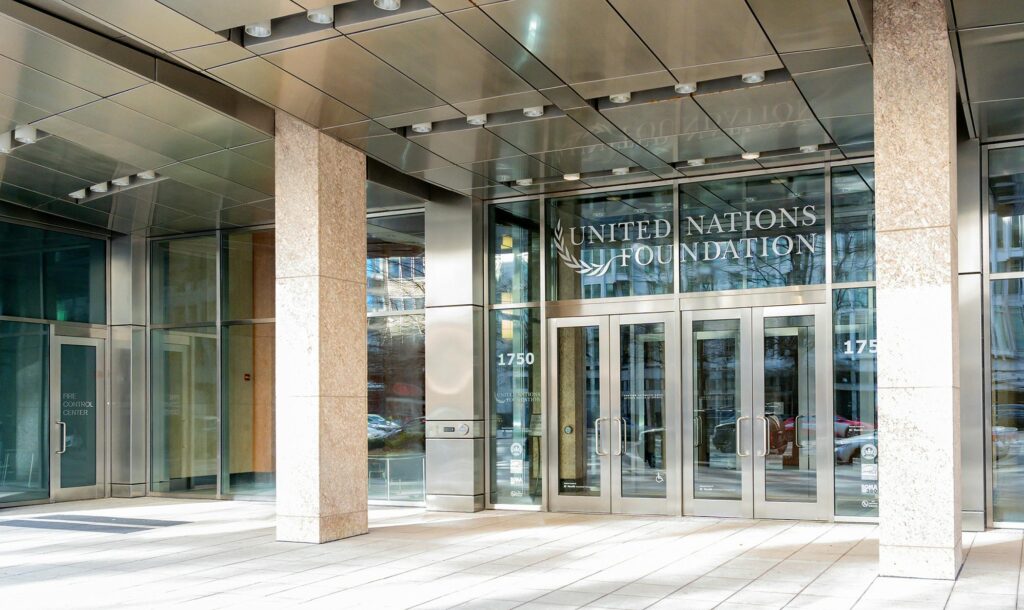

The entrance to UN Foundation headquarters in Washington, D.C. The building is gold-certified in Leadership in Energy and Environmental Design. Photo: JHVE Photo
Since our founding more than 25 years ago, the United Nations Foundation has been leading on environmental sustainability – not just as part of our core programs but also in our own operations. Today, we continue the work that began decades ago by renewing our commitment to climate action by offsetting emissions that we cannot otherwise reduce.
Since 1998, we have worked with the UN, government partners, and other critical actors to tackle the climate challenge. But achieving environmental sustainability should start at home — literally — in our operations, and in our offices. We have been actively working to phase out investments in fossil fuel exploration and development, while pursuing sustainable investments.
Our Washington, D.C. headquarters are housed in a building recognized by the U.S. Green Building Council as Gold Certified in Leadership in Energy and Environmental Design (LEED). That rating is more than a symbol on our front door – it’s a commitment to create a healthier work environment for our employees and to contribute to a healthier planet day-to-day.
As an early adopter of greenhouse gas (GHG) offsetting, the UN Foundation has been purchasing carbon credits to compensate for our greenhouse gas emissions for over two decades. Our proactive approach to quantifying and addressing our carbon footprint started in 2004, though our emissions were retroactively offset to cover the years dating back to the organization’s inception in 1998. We calculate GHG emissions every other year by collecting data from energy bills, business transportation, and other sources of emissions from our two main offices in Washington, D.C., and New York. The data is then multiplied by emissions factors relevant to each activity to determine the amount of carbon dioxide equivalents (CO2e) emitted.
By our calculations, in 2022 and 2023, the UN Foundation emitted approximately 1,200 metric tons of CO2-equivalent per year. While we believe these calculations have become more precise over time as the result of increasingly detailed guidelines from the GHG Protocol, the UN Foundation’s total emissions calculations also include a 10% buffer to cover any emissions we may have missed.
Though we have made concerted efforts to reduce our GHG emissions, including by offering a transit subsidy to employees to encourage sustainable commuting practices, some emissions are difficult to reduce, particularly in the transportation sector. While we are seeing a shift towards more sustainable practices in the transportation industry, as well as using technology to gather remotely rather than in person, travel is a good example of an area where it is currently impossible for the organization to directly reduce all of its emissions. That’s where offsets come in.
Purchasing GHG credits to offset emissions has several benefits. In addition to compensating for UN Foundation emissions that we can’t otherwise reduce, this approach helps fund decarbonization projects that would not have otherwise happened — while spurring technology advancement and innovation. Many of the projects also deliver social and economic benefits in the communities where they are implemented.
The UN Foundation thoroughly assesses each project by ensuring there is scientific data to confirm carbon reduction claims, which is essential when purchasing offsets from the voluntary carbon market where quality tends to vary. To cover our emissions from 2022 to 2023, we purchased carbon credits from two renewable energy projects. In addition to environmental benefits, both projects – one that supports biogas in Cambodia and the other, focused on wind energy in Thailand – provide significant social and economic benefits to the communities where they are located and have been rigorously vetted and certified through Gold Standard, a reputable global carbon registry that tracks the ownership, issuance, retirement, and transfer of voluntary carbon credits.
Through its 2022-23 carbon offset purchase, the UN Foundation is investing in two projects that reduce emissions in other parts of the world:

The Cambodia National Biodigester Programme reduces dependence on polluting firewood and fossil fuels used for cooking and lighting. Photo: Charlotte Pert/HIVOS
Cambodia National Biodigester Programme
The Cambodia National Biodigester Programme was one of the first large-scale biogas projects verified by Gold Standard, with support from the international development organization Hivos. Biodigesters, which run on animal waste and other organic material, reduce dependence on polluting firewood and expensive fossil fuels for cooking and lighting. They work by creating an oxygen-free environment that allows microorganisms, like bacteria, to break down organic material. There are two byproducts of this process: a gas largely composed of methane that can be used as a fuel source, and a nutrient rich bio-slurry that can be used as fertilization, which improves agricultural production.
This program advances six Sustainable Development Goals (SDGs): Affordable and clean energy (SDG 7), climate action (SDG 13), decent work and economic growth (SDG 8), good health and well-being (SDG 3), zero hunger (SDG 2), and gender equality (SDG 5). Environmental benefits of this program include 907,351 tons of CO2-equivalent reduced between May 2009 and December 2020 (which is equivalent to annual emissions of over 193,000 gas cars), and 293,300 tons of wood saved (which is equivalent to 3,200 acres of forest, roughly the size of the Los Angeles International airport). According to Gold Standard, the program’s biodigesters, which have benefited an estimated 80,000 people in Thailand, reduce kitchen air pollution by 88% and save households nearly $100 per year on average. In addition, the program has trained 964 masons and supervisors and freed up more time for learning and engaging in social activities.

The Cambodia National Biodigester Programme reduces dependence on polluting firewood and fossil fuels used for cooking and lighting. Photo: Charlotte Pert/HIVOS
Chaiyaphum Wind Power Project, Thailand
The Chaiyaphum Wind Farm project generates electricity using renewable wind energy. The project helps green Thailand’s electricity grid, which is still dominated by fossil fuel-based power plants. Wind turbines are 20%-40% efficient at converting wind into energy and are a highly sustainable energy source because they do not require a fuel source, they don’t emit greenhouse gasses or other pollutants, and the land around the turbines can still be used for nature or agricultural purposes.
This project primarily advances three SDGs: Affordable and clean energy (SDG 7), climate action (SDG 13), and decent work and economic growth (SDG 8). Environmental benefits include an estimated reduction of 117,849 tons of CO2-equivalent per year of greenhouse gases (which is equivalent to annual emissions of over 25,000 gas cars), and 245,484.01 MWh of renewable energy generated (which is enough to power over 17,500 houses for a year). This project has employed 65 local people to date.
The United Nations Foundation is leading by example in environmental sustainability. Our strategic approach to managing and mitigating GHG emissions underscores a commitment to our planet and the equitable support of communities affected by climate change. As the UN Foundation continues to grow, we remain dedicated to investing not only in our operational sustainability but also in global efforts to safeguard the planet and leave no one behind.
LEARN MORE
Discover how the UN Foundation is driving global progress on climate and the environment.

